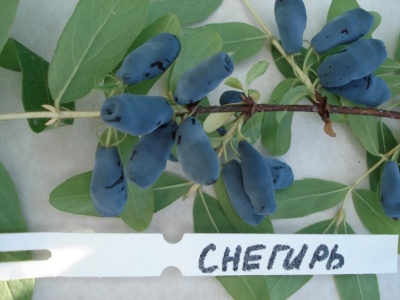
- Authors: VIR them. N. I. Vavilova
- Growth type: vigorous
- Description of the bush: slightly spreading
- Bush height, m: 1,5
- Escapes: annuals - red-brown, wavy, curved at the apex, heavily pubescent
- Leaves: rather large, oblong-ovate, with a sharp apex and rounded base, with pubescence along the edge
- Crown: reverse conical
- Fruit size: average and above average
- Fruit weight, g: 0,9
- Fruit shape: broadly fusiform
Honeysuckle Bullfinch is an excellent example of the work of breeders of the All-Russian Institute of Plant Industry named after N. Vavilov. This variety can be described in extremely superlative degrees. Its winter hardiness, large-fruited, unpretentious cultivation made the variety in demand among Russian gardeners. Statistics show that it is in Russia that the berry is very popular: this is due to its piquant taste, a rich set of trace elements and vitamins, and healing properties widely used in folk medicine.
Breeding history
Honeysuckle Bullfinch is sometimes called the Leningrad variety, although it was bred at the Pavlovsk experimental station of the VIR, opened in the 20s of the last century under the leadership of the famous scientist N. Vavilov. This is not the only example of edible honeysuckle - the Pavlovskaya and Volkhova varieties are well known to Russian gardeners. The bullfinch is distinguished by its large-fruited nature, high yield, resistance to pest attacks and common diseases. This is not surprising - elite seedlings and multiple pollination with pollen from other species were used to obtain the variety.
Description of the variety
The reverse conical shape of the bush without pruning and formation gives reason to some researchers to call this variety slightly spreading.
This is a vigorous bush, reaching a height of one and a half meters, which makes picturesque reddish-brown shoots and large pointed leaves of a dominant emerald color.
In addition to the presence of large berries with useful properties, it is decorative, perfect for landscape design. It can be grown on a plot of any size, without causing inconvenience to other bushes and trees.
Grows in partial shade and in the sun, winter-hardy and drought-resistant. The main pollinator is the magnificent Pavlovskaya honeysuckle, from which all the most valuable features were transmitted.
It is invariably present in the ratings of the best samples of Leningrad selection, varieties that are optimal for growing in unfavorable conditions of a temperate climate (long winter and short summer). It quickly begins to produce a crop that can be increased by providing the appropriate conditions.
Fruit characteristics
Honeysuckle Bullfinch is a large-fruited variety, with broadly spindle-shaped bluish-blue fruits, which become covered with a gray waxy bloom when they reach ripeness. They ripen in stages, but they can be harvested at the same time - the strong stalk does not allow the berries to crumble. Sometimes the berries are shaken off the bush onto a plastic wrap spread on the ground in the near-stem zone.
Transportability and keeping quality are below average, even when stored in a refrigerator, the berries quickly lose their presentation. But for your own use - this is a great option: they can be frozen, dried, eaten fresh, prepared compotes, jams, added to multicomponent preparations for the winter. The rich content of useful microelements and vitamins helps to optimize blood circulation, treats anemia, strengthens the immune system and vascular walls.
Taste qualities
Large berries have a delicate aroma that cannot be confused with other odors. It intensifies during heat treatment, and gives a unique aftertaste to complex twists.In Snegir, there is no bitterness inherent in less popular varieties, and the sweet and sour taste is due to the presence of fruit sugars and acids. Berries have a universal purpose: they are eaten fresh, and not only for medicinal purposes, but also just for pleasure.
Ripening and fruiting
The berries ripen by early to mid-July. The term may be postponed in a cold summer or due to the climatic conditions of the region. The disadvantage is called gradual ripening, but it is compensated by the fact that the berries do not crumble, but remain on the bushes due to the strong stalk.
Yield
The first fruits appear already in the second year after planting, but real harvests begin from 3-4 years. On average, 2-2.5 kg can be removed from each bush. For honeysuckle, this is an excellent indicator.

Self-fertility and the need for pollinators
Vigorous bushes depend on the presence of a similar species nearby (Pavlovskaya is recommended), but they live long and are an excellent honey plant.
Growing and care
Honeysuckle can be propagated in different ways, but experts advise purchasing seedlings from a nursery with a good reputation. The choice of location is determined by the illumination (partial shade is possible), the nature of the soil (sandy loam and loam with good drainage). Planting gives good results in spring and autumn, the optimal distance between the bushes is from one and a half meters. Watering, loosening the soil after natural precipitation, bait after harvesting, giving birth and in the fall - that's all that Bullfinch honeysuckle will require from a gardener. In return, it will give a wonderful harvest of healthy and tasty berries, a permanent decorative effect of the land.



































































